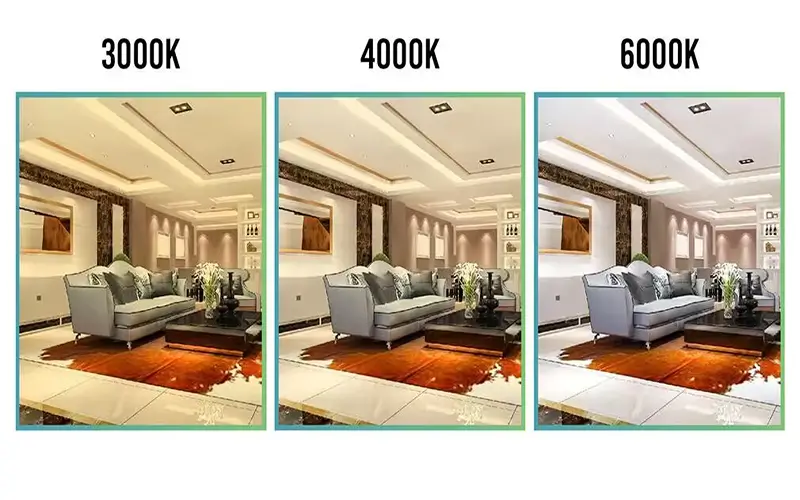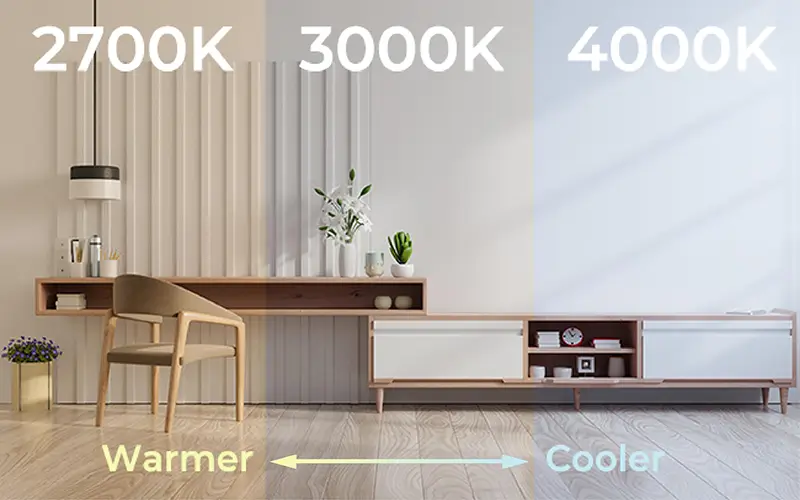
In the field of lighting, the color temperature of the lighting source plays a crucial role in determining the atmosphere and functionality of a space. Many people have been paying attention to the color temperature of LED lamps, and 4000K light is a common color temperature widely used in various applications.
In this article, we explore what 4000K is, 4000K light applications, and how to use it effectively in different environments.
What is 4000K Light?
The color temperatures of 4000K and 5000K can be regarded as transitional stages. People often compare the difference between 4000K vs. 5000K. Here, warm white tones of 2800K-3200K transition gradually to daylight tones of 6000K-6500K. When the light temperature reaches 6500K, it emits the brightest white light.
4000K lighting strikes a balance between warm and cool colors, providing lighting that is neither too dark nor too bright. 4000K Kelvin color temperature, often referred to as natural or neutral white light, meets the comfort and practical needs of residential or commercial spaces.
What are the Characteristics of 4000K Light?
4000K is widely used in residential and architectural lighting, both indoors and outdoors.
- Neutral white tone: 4000K It is a neutral white tone, not too warm or too cool. Because it produces a neutral white tone that is very similar to natural daylight.
- Balanced Lighting: 4000K lights provide a balanced blend of warm and cool tones to create a comfortable and welcoming atmosphere in residential and commercial spaces.
- Enhanced Visibility: The clarity and brightness of the 4000K light will enhance visibility tasks without causing glare.
Is 4000K too bright?
4000K light is neutral white light, but it is not too bright on its own. The light emitted by the 4000K is neither too warm nor too cold. If it is to neutralize the lighting at home, 4000K is very suitable. Indoors, 4000K color temperature provides optimal lighting without feeling too harsh. And it also improves visibility.

Where is 4000K mainly used?
4000K light is used in a wide variety of environments and applications. Mainly used for residential and architectural lighting.
Residential lighting: Kitchen and bathroom lighting. While improving visibility, it can also create a warmer and more comfortable atmosphere.
Commercial Lighting: Offices and workspaces improve productivity and focus. Thereby reducing fatigue.
Architectural Lighting: Enhance safety and visibility in outdoor areas such as parking lots, sidewalks, and building exteriors.
Impact of CRI on 4000K
As we know, the color rendering index (CRI) measures the ability of a light source to accurately render colors compared to natural sunlight. The higher the CRI value, the better the color rendering ability.
When choosing 4000K, we also need to pay special attention to the matching of CRI. It is best to choose 4000K with CRI90 or above. A high color rendering index ensures that colors are lifelike and vibrant, enhancing the overall visual appeal of the illuminated space.

How to Correctly Choose 4000K Light?
When you choose a 4000K fixture, first consider factors such as the purpose of the 4000K, the popularity of the installation, and the preferences of the occupants. Additionally, consideration needs to be given to whether users choose high-quality LED fixtures with adjustable brightness and dimming capabilities to customize lighting to specific requirements. You can find the 4000K light that suits you based on your needs.
In summary
4000K light blends warm and cool, neutral light tones in perfect harmony. Making it a versatile and adaptable lighting solution for a variety of applications. 4000K lighting illumination allows you to enjoy a comfortable atmosphere while improving visibility. Whether illuminating a workspace, home, or outdoor area, the 4000K lighting shines bright like a beacon of balanced lighting.
FAQs
4000K lighting refers to the color temperature emitted by a light source. And is measured in Kelvin (K). 4000K falls into the neutral white category, providing a mix of warm and cool. The natural white hue feels neither too warm nor too cool, making it suitable for a variety of lighting applications.
No, 4000K light is neither too warm nor too cold. It provides moderate brightness for tasks requiring clarity and visibility without causing glare or discomfort.
Features of the 4000K lighting include a neutral white color temperature. It offers a balance of tone, versatility and suitability for tasks requiring enhanced visibility and color rendering. It creates a comfortable atmosphere conducive to increased productivity and relaxation.
If used properly and not for long periods of time. 4000K color temperature will not cause damage to the eyes. Prolonged exposure to any artificial light source may cause eye strain or discomfort. It is crucial to maintain appropriate lighting levels and take regular breaks to reduce eye strain.
Yes, 4000K lighting can be used in areas such as outdoor parking lots, sidewalks, building exteriors, and landscape lighting. It provides clear, natural lighting while enhancing visibility and safety in outdoor environments. It feels very comfortable and doesn’t feel too dazzling.
